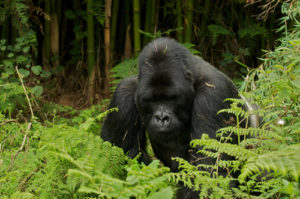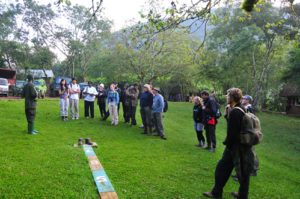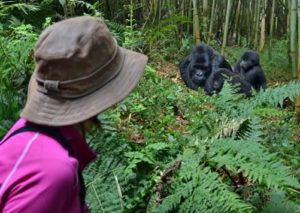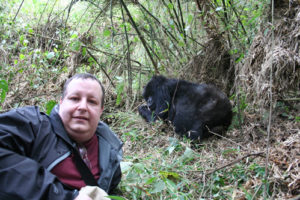What is gorilla trekking? Gorilla Trekking is a wildlife activity that involves hiking through dense forest in search of wild gorillas. The activity includes walking through steep hills, dense forest, rivers and water streams before finally encountering a gorilla family. Gorilla Trekking is led by park Rangers who often use machetes to create temporary paths through the foliage. Gorilla trekking is considered to be one of the most amazing wildlife activities in Africa. It is on par or to some even better than game drives to see the big 5 (lions, buffaloes, rhinos, leopards and elephants).
 Gorilla trekking is more expensive and special because it takes you for an encounter with a creature that resembles/behaves like we humans. Resemblance to humans aside, gorillas are generally endangered primates which makes an encounter with them even more appealing to tourists.
Gorilla trekking is more expensive and special because it takes you for an encounter with a creature that resembles/behaves like we humans. Resemblance to humans aside, gorillas are generally endangered primates which makes an encounter with them even more appealing to tourists.
After tracking the gorillas, you are allowed only one hour with them. If there was no time limit, you could spend the whole day marveling at a group of gorillas. Their behavior and family arrangement looks so familiar. You will see cheeky and stubborn juveniles climbing short trees, females breastfeeding, adults grooming each other and the dominant silverback always on the lookout for any troublemakers. Gorillas spend much of the day feeding and resting. The day ends with each member of the group making a nest for the night – except for the mothers who sleep with their infants. Each gorilla group is led by a silverback gorilla. Silverback gorillas protect the family from all kinds of intruders, including leopards and stray males. A silverback gorilla leads by example and charisma. Any rebellious members of the group are quickly put to order. When you read our article about gorilla mating, you will learn that the silverback gorilla has sole rights to all the females in the group.
 The Park Rangers will be there to Guide you during the time spent observing the primates. Do not forget your camera. Don’t use flash when taking photos of gorillas because it could alert them. Keep a distance of at least 7 meters from the nearest gorilla and never eat food near them. Remember there will be no fence separating you with the primates. They can decide to walk very close to you and you might be tempted to touch. Do not touch a gorilla and stay away from infants to avoid alerting mum and worse of all the silverback. The silverback can seem busy but will be watching your every move. Gorilla charging is very rare because they are generally peaceful primates. They may do mock charging just to reassert their dominance. In case a gorilla charges at you, never run away. Simply lay low and act submissive until it goes away.
The Park Rangers will be there to Guide you during the time spent observing the primates. Do not forget your camera. Don’t use flash when taking photos of gorillas because it could alert them. Keep a distance of at least 7 meters from the nearest gorilla and never eat food near them. Remember there will be no fence separating you with the primates. They can decide to walk very close to you and you might be tempted to touch. Do not touch a gorilla and stay away from infants to avoid alerting mum and worse of all the silverback. The silverback can seem busy but will be watching your every move. Gorilla charging is very rare because they are generally peaceful primates. They may do mock charging just to reassert their dominance. In case a gorilla charges at you, never run away. Simply lay low and act submissive until it goes away.
As earlier noted, Gorilla populations have reduced by over 50% in the last century. Their greatest threat is loss of habitat, poaching and human diseases. In Central Africa, gorillas are still hunted down for their meat and sold to zoos or as pets. Organizations like the Dian Fossey Gorilla Fund and Mountain Gorilla Fund are fighting tirelessly to protect the primates.
Why should you go for Gorilla Trekking?
Only Western Lowland gorillas can be seen in zoos. The other three subspecies (Mountain gorillas, Cross River Gorillas and Eastern Lowland gorillas) can only be seen in the wild. Because gorillas are ![]() rare, the thrill of seeing them in the wild is exciting. All gorilla species are considered endangered and that alone makes spotting them in the wild special. Gorilla trekking is also important because it is one way of contributing to gorilla conservation. Money raised from gorilla permits is used to train Park Rangers, fight poachers and build infrastructure for communities living close to the gorillas. When these communities see the benefits of tourism, they are less likely to harm gorillas. Finally, Gorillas are one of our closest relatives. Their DNA is 98% similar to ours. Why go see elephants and ignore a creature that behaves and looks like we humans? Moreover, tracking gorillas is so much more fun because it takes you deep into Africa’s jungles to discover pristine wilderness, birds, smaller primates and other rare creatures. You might be interested in an article about the cost of gorilla safaris.
rare, the thrill of seeing them in the wild is exciting. All gorilla species are considered endangered and that alone makes spotting them in the wild special. Gorilla trekking is also important because it is one way of contributing to gorilla conservation. Money raised from gorilla permits is used to train Park Rangers, fight poachers and build infrastructure for communities living close to the gorillas. When these communities see the benefits of tourism, they are less likely to harm gorillas. Finally, Gorillas are one of our closest relatives. Their DNA is 98% similar to ours. Why go see elephants and ignore a creature that behaves and looks like we humans? Moreover, tracking gorillas is so much more fun because it takes you deep into Africa’s jungles to discover pristine wilderness, birds, smaller primates and other rare creatures. You might be interested in an article about the cost of gorilla safaris.
Where to go for gorilla trekking
Gorilla trekking is arranged in many countries of Africa. You have to decide on which subspecies of gorillas you are interested in. Western Lowland gorillas are found in the swamps and rain-forests of West/Central Africa. Cross River gorillas are only found in Cameroon and Nigeria. Eastern Lowland Gorillas (The largest gorilla subspecies) are only found in the Democratic Republic of Congo. Mountain gorillas can be seen in Uganda, the Democratic Republic of Congo and Rwanda.
![]() Mountain gorilla trekking is the most popular with tourists. Why? Because they live in areas that are easier to access and where infrastructure is more developed. Western lowland gorillas live in very remote forests which are difficult to penetrate. To get to them, one may have to endure weeks of navigating through extremely dense forests.
Mountain gorilla trekking is the most popular with tourists. Why? Because they live in areas that are easier to access and where infrastructure is more developed. Western lowland gorillas live in very remote forests which are difficult to penetrate. To get to them, one may have to endure weeks of navigating through extremely dense forests.
Mountain gorilla trekking is also generally more secure. The Volcanoes National Park in Rwanda and Bwindi Impenetrable National Park in Uganda are generally safe for gorilla trekking. The two national parks are considered to be one of the best places to see gorillas. Compare that to the insecurity in certain parts of West and Central Africa and you can see why tourists are more comfortable doing gorilla trekking in the two countries. After spotting mountain gorillas, we highly recommend gorilla trekking in Kahuzi-Biega National Park of the Democratic Republic of Congo. You will discover pristine wilderness and a side of Africa that will take your breathe away. Best of all, you will encounter the largest Gorilla specie in the world. You can read an article about how to plan an affordable gorilla trekking adventure.
Best time for gorilla trekking
Gorilla trekking takes place all year round. However, since the primates live in rain forests, the best time to see them is during the drier seasons. Uganda, Rwanda and Congo are found close to the equator. This  means that they experience two rain and two dry seasons. The first dry season generally starts from December and ends in early March. The second rainy season starts from June and ends in early October. It is important to note that it could drizzle at any time of the year given that the primates live in rain forests. Global warming has also changed the rain patterns in Africa. It is therefore possible to find rain even during the dry seasons. Tourists prefer the dry season because the forest is less dense and the final encounter with the primates is not affected by rain. The forest trails are also less muddy hence less chance of tripping.
means that they experience two rain and two dry seasons. The first dry season generally starts from December and ends in early March. The second rainy season starts from June and ends in early October. It is important to note that it could drizzle at any time of the year given that the primates live in rain forests. Global warming has also changed the rain patterns in Africa. It is therefore possible to find rain even during the dry seasons. Tourists prefer the dry season because the forest is less dense and the final encounter with the primates is not affected by rain. The forest trails are also less muddy hence less chance of tripping.
What do you need for gorilla trekking?
 Although gorilla trekking is for everyone, you still need to be in good shape to complete a hike. If you are an elder, unfit or disabled, you should read about gorilla trekking for the elderly. You also need to be mentally and physically prepared to complete the activity regardless of the challenges ahead. Preparation means packing proper hiking boots, double-layered socks, gaiters, rain jackets and insect repellents. Do not forget drinking water and light snack when going out to track gorillas. Gorillas are susceptible to human diseases. No one with a cold, flu or similar contagious diseases will be allowed close to the gorillas.
Although gorilla trekking is for everyone, you still need to be in good shape to complete a hike. If you are an elder, unfit or disabled, you should read about gorilla trekking for the elderly. You also need to be mentally and physically prepared to complete the activity regardless of the challenges ahead. Preparation means packing proper hiking boots, double-layered socks, gaiters, rain jackets and insect repellents. Do not forget drinking water and light snack when going out to track gorillas. Gorillas are susceptible to human diseases. No one with a cold, flu or similar contagious diseases will be allowed close to the gorillas.
What are the chances of seeing gorillas? The chances of seeing mountain gorillas in the wild is now more than 98%. This is because a group of trackers are sent ahead of tourists. This advance group of trackers help find the exact location of the gorilla group and guide the team leading tourists using radio calls. There is no guarantee that you will see the primates during tracking but the chances of seeing them are very high indeed.

